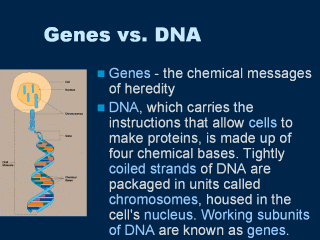|
|
|
|
front |1 |2 |3 |4 |5 |6 |7 |8 |9 |10 |11 |12 |13 |14 |15 |16 |17 |18 |19 |20 |21 |22 |23 |24 |25 |26 |27 |28 |29 |30 |31 |32 |33 |34 |35 |36 |37 |38 |39 |40 |Glossary |review |

|
Genes are working subunits of DNA. DNA is a vast chemical information database
that carries the complete set of instructions for making all the proteins a cell
will ever need. Each gene contains a particular set of instructions, usually
coding for a particular protein. DNA exists as two long, paired strands spiraled into the famous double helix. Each strand is made up of millions of chemical building blocks called bases. While there are only four different chemical bases in DNA (adenine, thymine, cytosine, and guanine), the order in which the bases occur determines the information available, much as specific letters of the alphabet combine to form words and sentences. DNA resides in the core, or nucleus, of each of the body's trillions of cells. Every human cell (with the exception of mature red blood cells, which have no nucleus) contains the same DNA. Each cell has 46 molecules of double-stranded DNA. Each molecule is made up of 50 to 250 million bases housed in a chromosome. The DNA in each chromosome constitutes many genes (as well as vast stretches of noncoding DNA, the function of which is unknown). A gene is any given segment along the DNA that encodes instructions that allow a cell to produce a specific product - typically, a protein such as an enzyme - that initiates one specific action. There are between 50,000 and 100,000 genes, and every gene is made up of thousands, even hundreds of thousands, of chemical bases. |